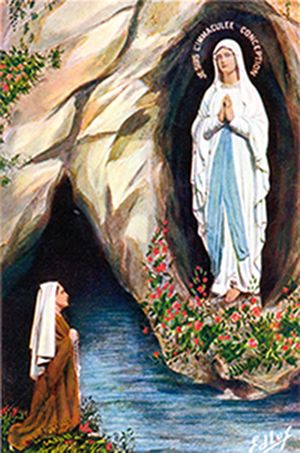Our Lady of Lourdes
Our Lady of Lourdes
February 11: Our Lady of Lourdes
— Reverend Matthew R. Mauriello
The story of Lourdes is well known. Between February 11 and July 16, 1858, the Blessed Virgin Mary appeared eighteen times to fourteen-year-old Bernadette Soubirous in that small town located in the foothills of the Pyrenee mountains of southern France.
Bernadette was born on January 7, 1844, the eldest of six children of Francis Soubirous and Louise Caserot. She was a delicate girl who suffered from asthma and cholera. She could neither read nor write and spoke only the Occitan dialect of her area. Her family was sinking into poverty, and the day the first apparition took place she went to gather firewood along the bank of the River Gave to help her mother.
Her attention was drawn to the noise of rustling bushes near the Grotto of Massabielle, from the French vieille masse meaning ancient mass. Then Bernadette saw a beautiful young girl of sixteen or seventeen. She described this girl as "dressed in a white robe, girded at the waist with a blue ribbon. She wore upon her head a white veil which gave just a glimpse of hair. Her feet were bare but covered by the last folds of her robe and a yellow rose was upon each of them. She held on her right arm a rosary of white beads with a chain of gold shining like the two roses on her feet."
Bernadette knelt and began to pray the rosary. At the end of the five decades the woman smiled and disappeared. The young visionary returned and on February 18 Our Lady began her message telling young Bernadette, "I do not promise to make you happy in this life but in the next." On February 24, Mary asked for penance and prayer for the conversion of sinners and the following day, she instructed Bernadette to dig the ground near the grotto. From that a spring came forth which to this day is used for the bath by pilgrims to Lourdes.
At the apparition of March 2, Bernadette was instructed by Our Lady to "tell the priests that people should come here in procession and that a chapel should be built on the site." On the Feast of the Annunciation, March 25, the Blessed Virgin told Bernadette in the dialect of Lourdes, " I am the Immaculate Conception." This dogma had been defined by Pope Pius IX just a few years earlier on December 8, 1854.
The Basilica at Lourdes was consecrated in 1876 and the faithful, countless in number, flock in pious pilgrimage to the holy grotto. It is there that their faith and devotion are aroused and they recommit themselves to conform their lives to the Christian message. There, as well, miraculous favors are granted and healings, both physical and spiritual, have taken place. Great emphasis is placed on devotion to the Eucharist and just as at the wedding feast of Cana, Mary points to her Son.
The liturgical feast of Our Lady of Lourdes was established for February 11, approved by Pope Leo XIII, and first granted to the Diocese of Tarbes in the year 1890. Less than twenty years later, on November 13, 1907, his successor, Pope St. Pius X proclaimed that it be observed throughout the universal Church.
The visionary Bernadette entered the Sisters of Notre Dame at Nevers in 1866 and was given the name of Sister Mary Bernarda. She worked there as sacristan and avoided publicity as best she could. She referred to herself as "a broom which Our Lady used, but now I have been put back in my corner." She died on April 16, 1879 at the young age of thirty-five, was beatified in 1925 by Pope Pius XI and canonized by him on the Feast of the Immaculate Conception, December 8, 1933. She appears in the church records as St. Mary Bernarda but in the hearts of the faithful she is affectionately remembered as St. Bernadette.
The above article appeared in the Fairfield County Catholic January 1996. Reprinted with permission of the author and publisher.
Image shown :
The Apparition-Lourdes
All About Mary includes a variety of content, much of which reflects the expertise, interpretations and opinions of the individual authors and not necessarily of the Marian Library or the University of Dayton. Please share feedback or suggestions with marianlibrary@udayton.edu.

